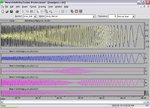vvierailija
Newbie
- Messages
- 4
- Likes
- 0
Hi
P.Z & Noxa Shame on you, you wrote as you are not Vendor of Noxa CSSA
post #2,#4 example. I think it''s cheating.
There is some rules in this web site.
I have been using noxa for two weeks now, it is promising..........
I think there is problem with Noxa and NeuroShell's GA fitness function = How good system is.
I hope in future it's possible to write own function which tells if system is good or not, these win-loss ratios,maximize account, probability etc...is not enough for noxa.
Like test if Wealth Lab Score, or Lissajous pattern.......... can help.
It can't find optimal/robust solution for Noxa, without doing semi automatic learning. stopping and retrain. It's not usually purpose of NN,GA and evolutionary learning systems.
It's crazy,people have to help technology and technology is not helping people.
If I can't find solution for that have to think how to use Noxa,not really want to think its waist of money.I hope I was reading end of this thread. and not read couple post where you and krys made arguments. and get tired.
I will not watch screen and wait and retrain, have to also do something else.
I think noxa or noxa/neuroshell combination can't generalize problem.
If noxa can make own GA/Fitness function to find good parameters. There is lot of free good GA code in net.
At Least you can make tutor where is step by step how to find good parameters,for groups start and group depths,and m-history a) using eigenvectors, b) what training functions works best,how many periods for learning etc.....
For me you help file is not enough, had to read this thread to get some usefull information.
Anyhow I will test two weeks more noxa because I allready have made several promising strategies lets see how they work in future.
P.Z & Noxa Shame on you, you wrote as you are not Vendor of Noxa CSSA
post #2,#4 example. I think it''s cheating.
There is some rules in this web site.
I have been using noxa for two weeks now, it is promising..........
I think there is problem with Noxa and NeuroShell's GA fitness function = How good system is.
I hope in future it's possible to write own function which tells if system is good or not, these win-loss ratios,maximize account, probability etc...is not enough for noxa.
Like test if Wealth Lab Score, or Lissajous pattern.......... can help.
It can't find optimal/robust solution for Noxa, without doing semi automatic learning. stopping and retrain. It's not usually purpose of NN,GA and evolutionary learning systems.
It's crazy,people have to help technology and technology is not helping people.
If I can't find solution for that have to think how to use Noxa,not really want to think its waist of money.I hope I was reading end of this thread. and not read couple post where you and krys made arguments. and get tired.
I will not watch screen and wait and retrain, have to also do something else.
I think noxa or noxa/neuroshell combination can't generalize problem.
If noxa can make own GA/Fitness function to find good parameters. There is lot of free good GA code in net.
At Least you can make tutor where is step by step how to find good parameters,for groups start and group depths,and m-history a) using eigenvectors, b) what training functions works best,how many periods for learning etc.....
For me you help file is not enough, had to read this thread to get some usefull information.
Anyhow I will test two weeks more noxa because I allready have made several promising strategies lets see how they work in future.

